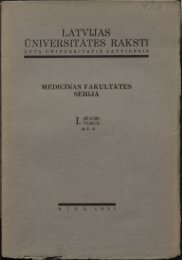ornamental sign language in the first order tracery belts - DSpace
ornamental sign language in the first order tracery belts - DSpace
ornamental sign language in the first order tracery belts - DSpace
Create successful ePaper yourself
Turn your PDF publications into a flip-book with our unique Google optimized e-Paper software.
Tenisons, M; Zeps, D. Ornamental Sign Language In The First Order Tracery Belts<br />
Abstract<br />
ORNAMENTAL SIGN LANGUAGE<br />
IN THE FIRST ORDER TRACERY BELTS<br />
Modris TENISONS *<br />
Da<strong>in</strong>is ZEPS †<br />
We consider an <strong>ornamental</strong> <strong>sign</strong> <strong>language</strong> of <strong>first</strong> <strong>order</strong> where pr<strong>in</strong>ciples of sieve displacement, of<br />
asymmetric build<strong>in</strong>g blocks as a base of ornament symmetry, color exchangeability and side<br />
equivalence pr<strong>in</strong>ciples work. Generic aspects of sieve and a genesis of <strong>ornamental</strong> pattern and<br />
ornament <strong>sign</strong>s <strong>in</strong> it are discussed. Hemiolia pr<strong>in</strong>ciple for <strong>ornamental</strong> genesis is <strong>in</strong>troduced. The<br />
discoverer of most of <strong>the</strong>se pr<strong>in</strong>ciples were artist Modris Tenisons [4, 5, 6, 7 (refs. 23, 24), 8 (ref.<br />
65)]. Here we apply a systematical research us<strong>in</strong>g simplest ma<strong>the</strong>matical arguments.<br />
We come to conclusions that ma<strong>the</strong>matical argument <strong>in</strong> aris<strong>in</strong>g ornament is of much more<br />
<strong>sign</strong>ificance than simply symmetries <strong>in</strong> it as <strong>in</strong> an image. We are after to <strong>in</strong>quire how ornament arises<br />
from global aspects <strong>in</strong>tertw<strong>in</strong>ed with <strong>the</strong>se local. We raise an argument of <strong>sign</strong>’s orig<strong>in</strong> from code<br />
ra<strong>the</strong>r from image, and its eventual impact on research of <strong>ornamental</strong> patterns, and on research of<br />
human prehension of <strong>sign</strong> and its connection with consciousness.<br />
Key words: b<strong>in</strong>ary cod<strong>in</strong>g, b<strong>in</strong>ary matrices, ornaments, asymmetry, <strong>sign</strong> cod<strong>in</strong>g, sieve <strong>in</strong> <strong>ornamental</strong><br />
pattern, <strong>first</strong> <strong>order</strong> complexity, hemiolia pr<strong>in</strong>ciple<br />
Contents<br />
Abstract ............................................................................................................................................ 1<br />
Introduction ...................................................................................................................................... 2<br />
The pr<strong>in</strong>ciple of removal of sieve <strong>in</strong> <strong>the</strong> <strong>first</strong> <strong>order</strong> belt and <strong>the</strong> code of <strong>the</strong> <strong>ornamental</strong> belt ............ 3<br />
Hemiolia pr<strong>in</strong>ciple – one and a half pr<strong>in</strong>ciple <strong>in</strong> <strong>the</strong> ornament genesis ............................................... 4<br />
Sieve displacement ........................................................................................................................... 5<br />
Creation of <strong>ornamental</strong> <strong>tracery</strong> from asymmetric elements .............................................................. 6<br />
The doubl<strong>in</strong>g of <strong>ornamental</strong> <strong>sign</strong>s by displacement of sieve .............................................................. 8<br />
The pr<strong>in</strong>ciple of <strong>the</strong> open<strong>in</strong>g of field <strong>in</strong>formation............................................................................... 9<br />
The <strong>sign</strong> <strong>language</strong> alphabet ............................................................................................................. 10<br />
The belt of Nica and its <strong>in</strong>vestigation ............................................................................................... 11<br />
* Correspondence: Modris Tenisons, artist, member of Artists' Union of Latvia, 11.Novembra krastmala 35,<br />
LV – 1050, Riga, Latvia, modris.tenisons@google.com, <strong>in</strong>fo@msav.lv<br />
† Da<strong>in</strong>is Zeps, PhD, Senior Researcher, Institute of Ma<strong>the</strong>matics and Computer Science, University of Latvia,<br />
Raiņa bulvāris 29, Rīga, Latvija, LV – 1459, da<strong>in</strong>ize@mii.lu.lv<br />
1
Tenisons, M; Zeps, D. Ornamental Sign Language In The First Order Tracery Belts<br />
“The belt of Nica teaches us”: <strong>the</strong> aes<strong>the</strong>tics <strong>in</strong> <strong>the</strong> <strong>belts</strong> of <strong>first</strong> <strong>order</strong> ............................................ 12<br />
Genesis of <strong>ornamental</strong> pattern: <strong>sign</strong> from code or vice versa ........................................................... 14<br />
Belts of higher <strong>order</strong> and <strong>the</strong>ir eventual <strong>in</strong>vestigation ..................................................................... 14<br />
Does <strong>the</strong>re exist <strong>first</strong> <strong>order</strong> complexity <strong>in</strong> <strong>the</strong> nature? ..................................................................... 15<br />
Acknowledgements ......................................................................................................................... 16<br />
References ...................................................................................................................................... 16<br />
Appendix. Code of <strong>the</strong> belt of Nica ................................................................................................. 17<br />
Introduction<br />
Ornaments and <strong>ornamental</strong> patterns are a part of both historical and cultural richness of<br />
different nations. What message <strong>the</strong>y convey? Can such question be justified scientifically?<br />
Ei<strong>the</strong>r, has such question legible mean<strong>in</strong>g what concerns exact sciences? In <strong>order</strong> to answer<br />
such and similar questions we must study <strong>the</strong>m. In this article we study ma<strong>the</strong>matically one<br />
type of ornament pattern found <strong>in</strong> <strong>ornamental</strong> <strong>belts</strong> of Baltic countries: for that reason we<br />
<strong>in</strong>troduce notion of <strong>the</strong> <strong>first</strong> <strong>order</strong> complexity <strong>ornamental</strong> <strong>sign</strong> <strong>language</strong>.<br />
Latvian national <strong>ornamental</strong> <strong>tracery</strong> <strong>belts</strong>, or, simpler, <strong>ornamental</strong> <strong>belts</strong> has been sufficiently<br />
widely studied <strong>in</strong> <strong>the</strong> past, e.g., [4,8,9,10]. The best known example is <strong>the</strong> belt of Lielvārde<br />
(little town <strong>in</strong> Latvia) [4,9,10], that has attracted enormous <strong>in</strong>terest of different researchers,<br />
but less from side of ma<strong>the</strong>maticians. Evident reason for that is <strong>the</strong> fact that this type of <strong>belts</strong><br />
has very complicate <strong>ornamental</strong> <strong>tracery</strong>. However <strong>the</strong>re are some sufficiently rich patterns of<br />
<strong>belts</strong> that are much simpler, e.g., belt of Nica (small rural district <strong>in</strong> Latvia) (see 1.pict.)[3].<br />
Just similar to this type of <strong>belts</strong> we are go<strong>in</strong>g to study <strong>in</strong> this article.<br />
In this article we systematize an experience of many years of Modris Tenisons <strong>in</strong> <strong>the</strong> area of<br />
<strong>the</strong> research of Latvian <strong>ornamental</strong> <strong>belts</strong> [4, 5, 6, 7 (refs. 23, 24), 8 (ref. 65)]. Next to <strong>the</strong><br />
experience of Latvian artist and <strong>ornamental</strong>istic researcher Modris Tenisons, we come across<br />
with researchers from o<strong>the</strong>r Baltic countries, namely, Lithuanian researcher Vytautas<br />
Tumėnas [7,8,9] and Estonian researcher Tõnis V<strong>in</strong>t [10].<br />
2
Tenisons, M; Zeps, D. Ornamental Sign Language In The First Order Tracery Belts<br />
Picture 1. The belt of Nica [3] <strong>in</strong> two sett<strong>in</strong>gs. The <strong>ornamental</strong> <strong>tracery</strong> should be read l<strong>in</strong>early from left upper<br />
corner to <strong>the</strong> right lower corner. See <strong>in</strong> <strong>the</strong> appendix <strong>the</strong> b<strong>in</strong>ary code of this belt. Length of <strong>the</strong> code is 751 rows.<br />
The image of <strong>the</strong> belt here was created by computer program. In <strong>the</strong> lower part is given <strong>the</strong> belt of Nica with <strong>the</strong><br />
opposite color<strong>in</strong>g. One of ma<strong>in</strong> pr<strong>in</strong>ciples <strong>in</strong> <strong>the</strong> <strong>first</strong> <strong>order</strong> <strong>ornamental</strong> <strong>tracery</strong> is that both colors are as if <strong>in</strong><br />
equilibrium <strong>in</strong> respect of amount of elements <strong>in</strong> it both globally and locally.<br />
The pr<strong>in</strong>ciple of removal of sieve <strong>in</strong> <strong>the</strong> <strong>first</strong> <strong>order</strong> belt and <strong>the</strong> code of<br />
<strong>the</strong> <strong>ornamental</strong> belt<br />
Analyz<strong>in</strong>g different k<strong>in</strong>ds of <strong>ornamental</strong> <strong>belts</strong> Modris Tenisons came to persuasion that <strong>the</strong>re<br />
may be dist<strong>in</strong>guished one type of <strong>belts</strong> that may be called <strong>first</strong> <strong>order</strong> <strong>belts</strong>. The ornament <strong>in</strong><br />
<strong>the</strong>se <strong>belts</strong> may be divided <strong>in</strong>to two parts, scilicet, <strong>the</strong> part of <strong>the</strong> sieve, and <strong>the</strong> part of <strong>the</strong><br />
code. We research <strong>in</strong> this article just this type of <strong>belts</strong> called <strong>first</strong> <strong>order</strong> <strong>belts</strong>. The <strong>language</strong><br />
of <strong>ornamental</strong> <strong>sign</strong>s used <strong>in</strong> <strong>the</strong>ses <strong>belts</strong> we call <strong>first</strong> <strong>order</strong> complexity <strong>ornamental</strong> <strong>sign</strong><br />
<strong>language</strong>.<br />
First <strong>order</strong> <strong>belts</strong> may be characterized by property that <strong>the</strong>re can be removed a sieve <strong>in</strong> <strong>the</strong>m<br />
leav<strong>in</strong>g a code alone. The pr<strong>in</strong>ciple of sieve removal or separation from <strong>the</strong> code, and <strong>the</strong>n<br />
cod<strong>in</strong>g <strong>in</strong> this sieve has been described <strong>in</strong> <strong>the</strong> article of Modris Tenisons and Armands<br />
Strazds [3]. The pr<strong>in</strong>ciple has been fixed also by patent of Modris Tenisons [4].<br />
If <strong>ornamental</strong> <strong>tracery</strong> <strong>in</strong> belt such as Nica belt is considered as two colored squared pattern,<br />
where checks <strong>in</strong> it has two colors, <strong>the</strong>n <strong>the</strong>re is <strong>the</strong> part that doesn’t change, and <strong>the</strong> chang<strong>in</strong>g<br />
part. The permanent part is called sieve, and <strong>the</strong> chang<strong>in</strong>g part – code. The sieve consists<br />
from two dual parts, where each is a lattice of cross elements, that is called cross lattice.<br />
Each cross element consists of five checks, naturally form<strong>in</strong>g <strong>the</strong> <strong>sign</strong> of <strong>the</strong> cross. See two<br />
dual cross lattices <strong>in</strong> pict. 3 <strong>in</strong> <strong>the</strong> middle image, where <strong>the</strong> cross elements of <strong>the</strong> cross<br />
lattices are correspond<strong>in</strong>gly of red and grey color. The chang<strong>in</strong>g part, that we call code,<br />
3
Tenisons, M; Zeps, D. Ornamental Sign Language In The First Order Tracery Belts<br />
consists from checks, where each such stands for one code unit. An <strong>ornamental</strong> <strong>tracery</strong><br />
is built fill<strong>in</strong>g (color<strong>in</strong>g) places of code with <strong>the</strong> color of one (or o<strong>the</strong>r) cross lattice. More<br />
precisely, assum<strong>in</strong>g <strong>the</strong> code to be b<strong>in</strong>ary code consist<strong>in</strong>g from zeros and units, choos<strong>in</strong>g by<br />
cod<strong>in</strong>g for zeros one color of cross lattice and for units o<strong>the</strong>r color of code lattice, we get an<br />
ornament as an image of an <strong>ornamental</strong> code. On <strong>the</strong> spot, we get <strong>first</strong> fundamental property,<br />
videlicet, <strong>the</strong>re arise eventually two traceries from one fixed <strong>ornamental</strong> code, <strong>in</strong>terchang<strong>in</strong>g<br />
<strong>the</strong> color of <strong>the</strong> code or <strong>the</strong> cross elements. We would have as if four choices here, but fur<strong>the</strong>r<br />
we are to see that opposite color<strong>in</strong>g of all <strong>ornamental</strong> pattern didn’t give different <strong>ornamental</strong><br />
<strong>tracery</strong>. For <strong>the</strong> cod<strong>in</strong>g it would mean that <strong>the</strong> opposite code, i.e., <strong>in</strong>terchang<strong>in</strong>g units and<br />
zeros, doesn’t give o<strong>the</strong>r <strong>ornamental</strong> pattern for <strong>the</strong> human prehension, though<br />
ma<strong>the</strong>matically does. In <strong>the</strong> pict. 3 we see <strong>ornamental</strong> pattern with six places for <strong>the</strong> code <strong>in</strong><br />
one row. We say that this is <strong>the</strong> belt of breadth six, as is <strong>the</strong> case of Nica belt. We consider <strong>in</strong><br />
this article only <strong>ornamental</strong> traceries and <strong>belts</strong> of breadth six, which is anyway m<strong>in</strong>imal<br />
nontrivial belt, as we should see, but sufficiently complex and problematic, as seen from<br />
Nica belt.<br />
In <strong>the</strong> example <strong>in</strong> pict. 3, <strong>ornamental</strong> code by fix<strong>in</strong>g only half due to suggested symmetry<br />
might be 011, 010, 100, 010, 011, 011, 010, 011, 010, 100 or <strong>in</strong> octal number system,<br />
3242332324.<br />
Picture 3. A pattern of <strong>ornamental</strong> trasery on right, that is coded <strong>in</strong> <strong>the</strong> sieve that stands on <strong>the</strong> left. In <strong>the</strong><br />
middle picture sieve is divided <strong>in</strong>to two dual parts, cross lattices, where each is colored dist<strong>in</strong>ctly, red and grey<br />
resp. Places for cod<strong>in</strong>g are clearly seen as check elements, accord<strong>in</strong>gly <strong>in</strong> white.<br />
Hemiolia pr<strong>in</strong>ciple – one and a half pr<strong>in</strong>ciple <strong>in</strong> <strong>the</strong> ornament genesis<br />
We may try to specify <strong>the</strong> sieve and <strong>the</strong> part of <strong>the</strong> code by some generic aspect with some<br />
<strong>in</strong>quiry where from it could arise. Let us assume <strong>in</strong> <strong>the</strong> foreground of <strong>the</strong> sieve be "<strong>tracery</strong>"<br />
of checkerboard with checks with arbitrary, white or red, color<strong>in</strong>g, and <strong>the</strong> code checks<br />
be<strong>in</strong>g as if shr<strong>in</strong>k<strong>in</strong>g of this foreground by <strong>the</strong> scale by at <strong>the</strong> same time, namely, <strong>the</strong><br />
shrunken squares are just checks. By this approach we have as if two grounds<br />
for <strong>the</strong> ornament to be enacted, scilicet, non chang<strong>in</strong>g background with checks, with <strong>the</strong><br />
color<strong>in</strong>g of chess-board, and chang<strong>in</strong>g by code foreground, and displaced by half-check,<br />
giv<strong>in</strong>g after 2/3 shr<strong>in</strong>k <strong>the</strong> code with checks and <strong>the</strong> whole <strong>ornamental</strong> pattern. To see<br />
this, say <strong>in</strong> <strong>the</strong> picture 3 <strong>in</strong> <strong>the</strong> middle, imag<strong>in</strong>e <strong>the</strong> grey (or red) places to be squares<br />
where corners are overlapped or partly covered with places of codes, squares, where<br />
white places have shrunken by scale . In this play of enact<strong>in</strong>g <strong>ornamental</strong> <strong>tracery</strong> some<br />
places are as if belong<strong>in</strong>g to non-chang<strong>in</strong>g background part, say, red, but some to codecolored<br />
and shrunken foreground – say, white.<br />
4
Tenisons, M; Zeps, D. Ornamental Sign Language In The First Order Tracery Belts<br />
We see that here <strong>the</strong> ratio 3/2 plays a decisive role. Besides, this ratio is <strong>sign</strong>ificant <strong>in</strong> some<br />
mystical teach<strong>in</strong>gs.<br />
We call this pr<strong>in</strong>ciple of aris<strong>in</strong>g ornament from volume parts of background and<br />
volume parts of code as if <strong>in</strong>terplay<strong>in</strong>g between <strong>the</strong>mselves that we describe here hemiolia<br />
pr<strong>in</strong>ciple. In Greek – one and a half.<br />
Sieve displacement<br />
The notion of sieve displacement arises by observ<strong>in</strong>g that displac<strong>in</strong>g <strong>the</strong> sieve by three<br />
checks or, what is <strong>the</strong> same, displacement of code by one row gives different ornament<br />
pattern that is equivalent of <strong>the</strong> exchange of colors of cross lattices. Thus, if we add empty<br />
code l<strong>in</strong>e <strong>in</strong> <strong>the</strong> ornament cod<strong>in</strong>g, we get quite a new <strong>ornamental</strong> pattern, that what we were<br />
to obta<strong>in</strong> by sieve displacement.<br />
Ma<strong>the</strong>matically, <strong>the</strong> th<strong>in</strong>gs we consider here are almost trivial, but <strong>the</strong>y effect on human<br />
imag<strong>in</strong>ation not <strong>in</strong> <strong>the</strong> least sense <strong>in</strong> a trivial manner. The discussion <strong>in</strong> this direction see<br />
below. Anyhow, let us bear <strong>in</strong> m<strong>in</strong>d that <strong>ornamental</strong> <strong>belts</strong>’ weavers who are directly<br />
connected with <strong>the</strong>se <strong>belts</strong>, because just <strong>the</strong>y are who have <strong>in</strong>vented <strong>the</strong>m, don’t know <strong>the</strong>se<br />
simple facts as clearly as <strong>the</strong>y stand <strong>in</strong> any ma<strong>the</strong>matical sett<strong>in</strong>g and never<strong>the</strong>less <strong>the</strong>y were<br />
and are able to obta<strong>in</strong> miracles quite <strong>in</strong> literal sense, like <strong>in</strong> <strong>the</strong> case of Nica belt, not even to<br />
speak about <strong>the</strong> belt of Lielvārde.<br />
Picture 4. Two ornament patterns from <strong>the</strong> same <strong>ornamental</strong> code. We may say that one is obta<strong>in</strong>ed by o<strong>the</strong>r<br />
us<strong>in</strong>g sieve displacement. We can see that we can’t fix <strong>the</strong> exact difference by “ma<strong>the</strong>matically non equipped<br />
eye” as some simple trick. Nei<strong>the</strong>r did most prolific masters as weavers of <strong>the</strong> most wonderful <strong>belts</strong>, who only<br />
“knew” <strong>the</strong> rule by some “<strong>in</strong>strumental” sense, that <strong>the</strong>y couldn’t formulate directly.<br />
Picture 5. The belt of Nica <strong>in</strong> two variations. On <strong>the</strong> right sieve displacement is performed by add<strong>in</strong>g empty<br />
code row at <strong>the</strong> beg<strong>in</strong>n<strong>in</strong>g giv<strong>in</strong>g ano<strong>the</strong>r pattern of Nica belt <strong>tracery</strong>. Visual effect is such as if we had quite<br />
ano<strong>the</strong>r sample of Nica belt.<br />
5
Tenisons, M; Zeps, D. Ornamental Sign Language In The First Order Tracery Belts<br />
In pict. 4 we see two ornament patterns from <strong>the</strong> same <strong>ornamental</strong> code. We may say that one<br />
is obta<strong>in</strong>ed by o<strong>the</strong>r us<strong>in</strong>g <strong>the</strong> sieve displacement. We can see that we can’t fix <strong>the</strong> exact<br />
difference by “ma<strong>the</strong>matically non equipped eye” as some simple trick. Nei<strong>the</strong>r did most<br />
prolific masters as weavers of <strong>the</strong> most wonderful <strong>belts</strong>, who only “knew” <strong>the</strong> rule by some<br />
“<strong>in</strong>strumental” sense that couldn’t formulate directly.<br />
Modris Tenisons discovered <strong>the</strong> sieve removal and sieve displacement pr<strong>in</strong>ciple <strong>in</strong> <strong>the</strong> late<br />
seventies of <strong>the</strong> previous century. The discovery is fixed <strong>in</strong> a patent as an <strong>in</strong>tellectual game<br />
[5].<br />
Creation of <strong>ornamental</strong> <strong>tracery</strong> from asymmetric elements<br />
Modris Tenisons developed an idea that <strong>the</strong> code of <strong>the</strong> belt should be built from asymmetric<br />
elements, i.e., that <strong>in</strong> <strong>the</strong> base of <strong>the</strong> supposed symmetric <strong>ornamental</strong> <strong>tracery</strong> should stand<br />
asymmetry. In <strong>order</strong> to illustrate this idea, let us characterize a type of <strong>ornamental</strong> belt that is<br />
built from asymmetric elements that are called seeds of chaos.<br />
Let us consider element – two-colored matrix where four checks are pa<strong>in</strong>ted<br />
asymmetrically with respect to <strong>the</strong> middle row, middle column and both diagonals. How<br />
many such elements exist that are not equal with respect to <strong>the</strong>se already named symmetric<br />
transformations? It turns out that – ten, see pict. 6. This simple but not trivial ma<strong>the</strong>matical<br />
fact we formulate as a <strong>the</strong>orem (Modris Tenisons).<br />
Theorem 1 (Modris Tenisons). There are exactly b<strong>in</strong>ary matrices with exactly four<br />
units that are without automorphisms and not isomorphic with respect to reflections versus<br />
middle row, middle column and both diagonals.<br />
Proof. The <strong>the</strong>orem may be checked by direct enumeration. See <strong>in</strong> picture 6 all <strong>the</strong>se 10<br />
possible matrices where units are de<strong>sign</strong>ated by red checks and zeros by white checks.<br />
Picture 6. Ten asymmetric elements named by M. Tenisons seeds of chaos. Each of <strong>the</strong>m characterize<br />
equivalence class of eight elements – matrices which are asymmetric versus vertical and horizontal and<br />
diagonal reflections. Toge<strong>the</strong>r <strong>the</strong>re are 80 such elements because <strong>the</strong>ir asymmetry doesn’t allow <strong>the</strong> number of<br />
elements to „break down” due to symmetries. However, <strong>the</strong>re are 46 symmetric elements <strong>in</strong> equivalence<br />
classes. Factorization as simple as <strong>in</strong> case of asymmetry is “broken down” by two extra symmetric elements that<br />
are symmetric versus all allowed symmetries, i.e., doesn’t divide .<br />
The next <strong>the</strong>orem is very relevant for <strong>the</strong> build<strong>in</strong>g of <strong>ornamental</strong> traceries <strong>in</strong> <strong>the</strong> <strong>first</strong> <strong>order</strong><br />
<strong>belts</strong>.<br />
6
Tenisons, M; Zeps, D. Ornamental Sign Language In The First Order Tracery Belts<br />
Theorem 2 There are exactly b<strong>in</strong>ary matrices with exactly 4 units that are without<br />
automorphisms with respect to reflections versus middle row and middle column and both<br />
diagonals.<br />
Proof This <strong>the</strong>orem differs from <strong>the</strong> previous that <strong>the</strong> condition of non isomorphism is<br />
removed. Because elements are asymmetric <strong>in</strong> <strong>the</strong> mentioned sense <strong>the</strong>y factorize <strong>in</strong> 10<br />
classes of equivalence where each class has elements. Altoge<strong>the</strong>r we get<br />
matrices.<br />
Let us try to get this number 80 without reference to previous <strong>the</strong>orem. In total we have<br />
b<strong>in</strong>ary matrices with units. Let us subtract <strong>the</strong> symmetric ones. We have<br />
symmetric matrices with respect to middle row 12, accord<strong>in</strong>gly, with no unit <strong>in</strong> middle row –<br />
3, and with two unites – 9. This number should be multiplied by 4. Two matrices were with<br />
all units <strong>in</strong> all corners, and no unit <strong>in</strong> corners. These came <strong>in</strong> <strong>the</strong> count with repetition<br />
because of excessive symmetry, thus <strong>the</strong>y we should re-subtract. Thus, we get<br />
. ■<br />
Let us try to build <strong>ornamental</strong> <strong>tracery</strong> from <strong>the</strong>se asymmetric elements we call seeds of<br />
chaos, that are <strong>in</strong> total factorized <strong>in</strong> clases of equivalence. Let us <strong>first</strong> try to count how<br />
many <strong>ornamental</strong> <strong>sign</strong>s we may build <strong>in</strong> <strong>the</strong> most simple <strong>ornamental</strong> <strong>tracery</strong> from <strong>the</strong>se<br />
asymmetric elements.<br />
Def<strong>in</strong>ition 1 Let us call <strong>first</strong> level <strong>ornamental</strong> <strong>sign</strong> code or, simpler, <strong>ornamental</strong> <strong>sign</strong> code or<br />
<strong>sign</strong> code to be a element that is built from 4 asymmetric elements which are<br />
symmetric ei<strong>the</strong>r with respect to both vertical and horizontal reflection, or with respect to a<br />
rotation of elements, all versus <strong>the</strong> center of <strong>the</strong> element, (see pict. 7).<br />
Def<strong>in</strong>ition 2 Let us say that two <strong>sign</strong> codes are equivalent if <strong>the</strong>y are element's<br />
reflection of rows, (see pict.7).<br />
Def<strong>in</strong>ition 2 <strong>in</strong>troduces a simple pr<strong>in</strong>ciple of right and left side equivalence <strong>in</strong> <strong>the</strong> belt,<br />
namely, accord<strong>in</strong>g which belt is readable from both sides equally. This pr<strong>in</strong>ciple has more<br />
deep methodological mean<strong>in</strong>g <strong>in</strong> <strong>the</strong> mak<strong>in</strong>g dist<strong>in</strong>ction between human prehension and<br />
ma<strong>the</strong>matical, see below.<br />
Let us consider allowed <strong>sign</strong> codes by def<strong>in</strong>ition 1 (see <strong>in</strong> pict. 7).<br />
Pict. 7. The illustration of def<strong>in</strong>ition 1. Let us assume <strong>in</strong> <strong>the</strong> place of symbol „R” whatever asymmetric<br />
element with whatever orientation. On <strong>the</strong> left, element shows how <strong>the</strong> code of a <strong>sign</strong> may be built us<strong>in</strong>g<br />
two orthogonal reflections of element. On <strong>the</strong> right <strong>in</strong> two pictures <strong>the</strong> code of a <strong>sign</strong> is built us<strong>in</strong>g two<br />
possible rotations, clockwise and anticlockwise respectively, of element. Two depicted cases by<br />
def<strong>in</strong>ition 2 are dealt as equivalent. This equivalence doesn’t affect <strong>the</strong> <strong>first</strong> way of build<strong>in</strong>g of a code of <strong>sign</strong><br />
because <strong>the</strong> code <strong>in</strong> this case is already symmetric, say, with respect to <strong>the</strong> vertical reflection.<br />
7
Tenisons, M; Zeps, D. Ornamental Sign Language In The First Order Tracery Belts<br />
Theorem 3 (Modris Tenisons) There are nonequivalent codes of <strong>sign</strong>s.<br />
Proof Let us show that only different codes of <strong>sign</strong>s can be built with allowed<br />
operations by def<strong>in</strong>itions 1 and 2.<br />
Let us consider <strong>the</strong> way to build code of <strong>sign</strong> us<strong>in</strong>g def<strong>in</strong>ition 1 where asymmetric element<br />
should be symmetric with respect to vertical and horizontal reflections, (see pict. 7 left<br />
side). In place of asymmetric element we can place elements accord<strong>in</strong>g <strong>the</strong> <strong>the</strong>orem<br />
2, which all should give different codes of <strong>sign</strong>s. We get codes of <strong>the</strong> <strong>sign</strong>.<br />
Let us consider second way of how to build code of <strong>sign</strong> by rotation (see pict. 7 middle and<br />
right side). There similarly we get codes of <strong>sign</strong>, but half of <strong>the</strong>se codes would be<br />
symmetric with respect to vertical reflection and accord<strong>in</strong>g def<strong>in</strong>ition 2 should be excluded<br />
as be<strong>in</strong>g equivalent. In <strong>the</strong> result we get only non equivalent codes of <strong>sign</strong>s. Toge<strong>the</strong>r we<br />
get codes of <strong>sign</strong> as stated by <strong>the</strong>orem.<br />
O<strong>the</strong>r ways of build<strong>in</strong>g code of <strong>sign</strong> we do not have. Thus, <strong>the</strong> <strong>the</strong>orem is proved. ■<br />
The doubl<strong>in</strong>g of <strong>ornamental</strong> <strong>sign</strong>s by displacement of sieve<br />
We already considered sieve displacement that gives ano<strong>the</strong>r <strong>ornamental</strong> <strong>tracery</strong>. As we saw<br />
sieve consists from two dual lattices of cross elements that may be <strong>in</strong>terchanged by<br />
displacement by three checks. Hav<strong>in</strong>g two colors, say, white and red, let one lattice get white<br />
color and o<strong>the</strong>r red color: us<strong>in</strong>g by cod<strong>in</strong>g white color we get one <strong>ornamental</strong> <strong>tracery</strong>, and red<br />
colored code would give ano<strong>the</strong>r, different <strong>ornamental</strong> <strong>tracery</strong>. The same may be atta<strong>in</strong>ed by<br />
displacement of sieve, that could be performed, say, by enter<strong>in</strong>g <strong>the</strong> empty l<strong>in</strong>e of code. But<br />
this consideration gives us way to build from one code of <strong>sign</strong> two different <strong>ornamental</strong><br />
<strong>sign</strong>s. This gives us right for <strong>the</strong> next <strong>the</strong>orem.<br />
Theorem 4 (Modris Tenisons). 120 non equivalent codes of <strong>sign</strong> give 240 dist<strong>in</strong>ct ornament<br />
<strong>sign</strong>s us<strong>in</strong>g sieve displacement.<br />
Proof If <strong>sign</strong>s are divided <strong>in</strong>to two classes with respect to sieve configuration, <strong>the</strong>n no <strong>sign</strong><br />
from one class may be equal with <strong>sign</strong> from o<strong>the</strong>r class, because <strong>the</strong> sieve itself plays<br />
decisive role: sieve <strong>in</strong> one class is as if displaced versus o<strong>the</strong>r class. This argument completes<br />
<strong>the</strong> proof of <strong>the</strong> <strong>the</strong>orem. ■<br />
See pict. 9 for illustration, where <strong>the</strong> same code gave two different <strong>sign</strong>s which become<br />
<strong>in</strong>terchanged by sieve displacement. In <strong>order</strong> to get succession of two equivalent <strong>sign</strong>s we<br />
had to divide <strong>the</strong> code of <strong>sign</strong>s by <strong>the</strong> empty l<strong>in</strong>e of <strong>the</strong> code.<br />
Pict. 8. Sieve displacement with respect to <strong>the</strong> same code. Sign „Fish” or “zivtiņa”.<br />
8
Tenisons, M; Zeps, D. Ornamental Sign Language In The First Order Tracery Belts<br />
Pict. 9. Chang<strong>in</strong>g colors <strong>in</strong> an <strong>ornamental</strong> <strong>tracery</strong> we get ano<strong>the</strong>r one. However this change does not effect to<br />
<strong>the</strong> same extent than by sieve displacement: we may discern previous <strong>ornamental</strong> <strong>tracery</strong> by our imag<strong>in</strong>ation.<br />
Pictures 9 and 10 show that sieve displacement and color <strong>in</strong>terchange work <strong>in</strong> different way<br />
<strong>in</strong> ornament build<strong>in</strong>g.<br />
Actually we could <strong>in</strong>troduce one more feasibility to double number of codes of <strong>sign</strong>s, scilicet,<br />
<strong>in</strong> place of asymmetric code allow<strong>in</strong>g to be its dual element, namely, asymmetric<br />
element with five units. But this would lead to some disbalance of colors or brightness of<br />
colors <strong>in</strong> <strong>ornamental</strong> <strong>tracery</strong>, scilicet, 5-unit elements would give more colored <strong>tracery</strong> that<br />
4-unit elements and com<strong>in</strong>g <strong>the</strong>m alternately would give place to disbalance of brightness of<br />
ornament. Thus, here we see where pure ma<strong>the</strong>matical argument may come <strong>in</strong> conflict with<br />
some artistic pr<strong>in</strong>ciple and human prehension: ma<strong>the</strong>matics would say that we may have<br />
<strong>sign</strong> codes whereas artistic pr<strong>in</strong>ciples would force us to restra<strong>in</strong> only to <strong>sign</strong> codes.<br />
The pr<strong>in</strong>ciple of <strong>the</strong> open<strong>in</strong>g of field <strong>in</strong>formation<br />
Modris Tenisons came to build<strong>in</strong>g ornament <strong>sign</strong>s <strong>in</strong> a little different way, namely, us<strong>in</strong>g<br />
pr<strong>in</strong>ciple of <strong>the</strong> open<strong>in</strong>g of field of <strong>in</strong>formation. Let us try to consider his approach, us<strong>in</strong>g<br />
some systematic argument.<br />
Let us <strong>first</strong> consider a little different proof to <strong>the</strong> <strong>the</strong>orem 3. Let us consider pict.8a on <strong>the</strong> left<br />
where we use two orthogonal reflections of elements, gett<strong>in</strong>g <strong>in</strong> this way ways of<br />
build<strong>in</strong>g a code of <strong>sign</strong>. Similarly let us do rotation of element accord<strong>in</strong>g <strong>the</strong> schema <strong>in</strong><br />
pict.8a on right: we do rotation of each corner gett<strong>in</strong>g codes of <strong>sign</strong>s. Two <strong>sign</strong>s are to be<br />
excluded to escape repetitions. Toge<strong>the</strong>r we get schemata that for asymmetric<br />
elements would give different codes of <strong>sign</strong>s. In this way we didn’t even use <strong>the</strong><br />
def<strong>in</strong>ition 2. Why? It turns out that <strong>the</strong> performance of rotation only <strong>in</strong> one direction is<br />
equivalent with <strong>the</strong> use of <strong>the</strong> def<strong>in</strong>ition 2 that <strong>in</strong>troduces equivalence of left and right sides<br />
of <strong>ornamental</strong> <strong>tracery</strong>. Allow<strong>in</strong>g rotations <strong>in</strong> both directions would result <strong>in</strong> gett<strong>in</strong>g<br />
repetitions of code that <strong>the</strong> def<strong>in</strong>ition 2 excludes.<br />
Pict.9. An example of <strong>the</strong> build<strong>in</strong>g of <strong>the</strong> code of <strong>sign</strong>. On <strong>the</strong> left one asymmetric element gives four codes of<br />
<strong>sign</strong>, correspond<strong>in</strong>gly <strong>in</strong> each corner, with asymmetric element <strong>in</strong> <strong>the</strong> center. In <strong>the</strong> picture <strong>in</strong> center and on <strong>the</strong><br />
9
Tenisons, M; Zeps, D. Ornamental Sign Language In The First Order Tracery Belts<br />
right from <strong>the</strong> same asymmetric element we get codes of <strong>sign</strong> only by twos <strong>in</strong> two pictures because of<br />
repetitions. Clearly is seen <strong>the</strong> occurence of double overlap by rotation symmetry.<br />
Let us try to follow <strong>the</strong> idea of Modris Tenisons about <strong>the</strong> open<strong>in</strong>g of field of <strong>in</strong>formation. If<br />
<strong>in</strong> place of asymmetric elements we had symmetric, <strong>the</strong>n <strong>the</strong> number of different elements<br />
would be less because every symmetry tends to reduce correspond<strong>in</strong>g number at least by .<br />
Some analogy may be <strong>the</strong> fact that symmetric elements with five zeros give classes<br />
of equivalence that do not factorize as simple as <strong>in</strong> case of asymmetry, namely, when number<br />
of all matrices is . Two exceed<strong>in</strong>gly symmetric matrices, with units <strong>in</strong> corners and no unit<br />
<strong>in</strong> corner, breaks down simplicity of count, e.g., .<br />
Let us try to reason how Modris Tenisons does it <strong>in</strong> his workshops of ornament creation (see<br />
[1]). Let us take asymmetric element and open it <strong>in</strong> all direction with reflections, fill<strong>in</strong>g<br />
corner squares too as <strong>in</strong> pict. 9. Go<strong>in</strong>g on with such „open<strong>in</strong>g” we wouldn’t get new<br />
<strong>in</strong>formation because of repetitions. If <strong>in</strong> place of asymmetric element we had taken<br />
someth<strong>in</strong>g symmetric we didn’t get even this amount of <strong>in</strong>formation, but we had already<br />
repetitions. Speak<strong>in</strong>g <strong>in</strong>formally, <strong>in</strong>formation for us is that that do not repeat. But, let us<br />
imag<strong>in</strong>e <strong>in</strong> place of what we see to be dimensions <strong>in</strong> some subspaces: repetitions <strong>the</strong>re would<br />
mean no <strong>in</strong>formation already directly. In place of <strong>in</strong>formation here we might use term –<br />
access to <strong>in</strong>formation, and quantity – degrees of freedom, and that would give us more<br />
justification for <strong>the</strong> use of <strong>the</strong>se notions <strong>in</strong> way Modris Tenisons do.<br />
Let us consider how many unrepeatable <strong>in</strong>formation we might get. We have equivalence<br />
classes of asymmetric elements and elements. Informally we might say that <strong>the</strong>orem 3<br />
counts number of <strong>in</strong>formation occurrances or degrees of freedom <strong>in</strong> <strong>the</strong> generation of code of<br />
<strong>first</strong> level.<br />
Pict. 9. field where each of <strong>the</strong>m is matrix for build<strong>in</strong>g code of <strong>sign</strong> where with slash is depicted<br />
imag<strong>in</strong>able asymmetric element. Such slashes <strong>in</strong> <strong>the</strong> <strong>language</strong> of build<strong>in</strong>g of <strong>ornamental</strong> <strong>sign</strong>s denotes<br />
<strong>the</strong>ir generic elements that artists are used to. On <strong>the</strong> right some examples of such <strong>sign</strong> build<strong>in</strong>gs: <strong>the</strong> <strong>sign</strong> of<br />
Māra (“Māras zīme”) that arises from <strong>the</strong> union of any two opposite, mascul<strong>in</strong>e and fem<strong>in</strong><strong>in</strong>e, elements;<br />
„eternity”; „fish <strong>sign</strong>”; „crayfish <strong>sign</strong>” or „cancer”. See o<strong>the</strong>r examples <strong>in</strong> [7,8,9]. All <strong>the</strong>se <strong>sign</strong>s except <strong>the</strong> last<br />
may be placed <strong>in</strong> this field of code. The slash works as if a variable that may have received possible<br />
values. For example, we may form samples of „Māras zīme”, etc.<br />
The <strong>sign</strong> <strong>language</strong> alphabet<br />
Let us consider a simple idea of how from sieve displacement and ornament cod<strong>in</strong>g we may<br />
come to <strong>sign</strong> alphabet <strong>in</strong> <strong>the</strong> <strong>first</strong> <strong>order</strong> (complexity) <strong>belts</strong>. Two follow<strong>in</strong>g rows <strong>in</strong> <strong>the</strong> code <strong>in</strong><br />
case when ornament code width is, say, six may be divided <strong>in</strong>to b<strong>in</strong>ary fields. Each<br />
10
Tenisons, M; Zeps, D. Ornamental Sign Language In The First Order Tracery Belts<br />
such field may be considered as a letter <strong>in</strong> <strong>the</strong> 16 <strong>sign</strong> alphabet. For a b<strong>in</strong>ary code of such<br />
form it would be a trivial step with trivial such an alphabet. But <strong>in</strong> case <strong>the</strong>se b<strong>in</strong>ary fields<br />
“work” toge<strong>the</strong>r with <strong>the</strong> sieve, <strong>the</strong>y make 16 <strong>sign</strong>s for <strong>ornamental</strong> <strong>sign</strong> <strong>language</strong> alphabet.<br />
Actually we get two such possible alphabets us<strong>in</strong>g sieve displacement. Every belt of width 6<br />
may be cut <strong>in</strong>to such square elements stand<strong>in</strong>g for <strong>ornamental</strong> <strong>sign</strong> alphabet letters because<br />
we should get <strong>in</strong>variantly only 16 such alphabet letters by simple b<strong>in</strong>ary code argument.<br />
Pict. 9. Illustration how <strong>sign</strong> alphabet arises from simple b<strong>in</strong>ary code. On <strong>the</strong> left example of two b<strong>in</strong>ary<br />
columns from two rows – b<strong>in</strong>ary matrix<br />
. Putt<strong>in</strong>g this code <strong>in</strong>to <strong>the</strong> sieve we receive one alphabet letter of<br />
<strong>the</strong> <strong>sign</strong> alphabet, as <strong>in</strong> <strong>the</strong> center, and on <strong>the</strong> right where places of code are marked. Every belt of width 6 may<br />
be cut <strong>in</strong>to such square elements stand<strong>in</strong>g for <strong>ornamental</strong> <strong>sign</strong> alphabet letters because we should get <strong>in</strong>variantly<br />
only 16 such alphabet letters by <strong>the</strong> simple b<strong>in</strong>ary code argument.<br />
Modris Tenisons patent [5] actually is for this <strong>sign</strong> alphabet, that <strong>in</strong> <strong>in</strong>direct way conta<strong>in</strong>s<br />
ideas of sieve displacement and <strong>ornamental</strong> cod<strong>in</strong>g.<br />
Pict. 10. 16 letters of <strong>the</strong> <strong>ornamental</strong> <strong>sign</strong> <strong>language</strong> alphabet. Would this alphabet of Modris Tenisons be<br />
sufficient to code belt of Nica? ... <strong>in</strong> sense how any <strong>first</strong> <strong>order</strong> <strong>ornamental</strong> pattern may be composed by <strong>the</strong>se<br />
squares as puzzle? Ma<strong>the</strong>matically it is trivially if we only notice that this is <strong>the</strong> full b<strong>in</strong>ary code <strong>in</strong> <strong>the</strong> sieve. By<br />
<strong>the</strong> sieve displacement we get ano<strong>the</strong>r such alphabet that is different from this one.<br />
The belt of Nica and its <strong>in</strong>vestigation<br />
Modris Tenisons has proposed idea that <strong>the</strong> belt of Nica is built from asymmetric elements<br />
too, similarly as we described higher [4]. But it turns out not to be so simple. If we directly<br />
search after asymmetric elements <strong>in</strong> <strong>the</strong> belt of Nica, we do not get <strong>the</strong>m sufficiently<br />
11
Tenisons, M; Zeps, D. Ornamental Sign Language In The First Order Tracery Belts<br />
many to get complete cover of all <strong>the</strong> belt. We come to a question how <strong>the</strong> code of <strong>the</strong> belt of<br />
Nica is built if we want to stick around <strong>the</strong> ideas of Tenisons about asymmetry as basis of<br />
symmetry <strong>in</strong> <strong>ornamental</strong> <strong>tracery</strong> of belt?<br />
We may now ask. How weaver could come to belt that is as rich as <strong>the</strong> belt of Nica? One<br />
<strong>in</strong>terpretation is sufficiently simple. Toge<strong>the</strong>r with <strong>the</strong> experience by weav<strong>in</strong>g <strong>in</strong>strumental<br />
experience heaps up. Weavers better remember „<strong>in</strong>strumental” experience than, say, visual,<br />
namely, <strong>the</strong>y remember technological and <strong>in</strong>strumental <strong>in</strong>formation how <strong>the</strong>y do anyth<strong>in</strong>g by<br />
weav<strong>in</strong>g ra<strong>the</strong>r <strong>in</strong> some o<strong>the</strong>r way. In much simpler case, exempli gratia, knitter remembers<br />
comb<strong>in</strong>ations of stitches ra<strong>the</strong>r than anyth<strong>in</strong>g else. The same but <strong>in</strong> more complex sett<strong>in</strong>g<br />
applies for weaver of <strong>belts</strong>. The belt of Lielvārde shows that this assumed <strong>in</strong>strumental<br />
experience that might be <strong>in</strong>credibly complex may produce real wonders. Widely used<br />
allusion to an <strong>in</strong>formation from <strong>the</strong> Cosmos <strong>in</strong> this context [1] might have some ground,<br />
though not subject to direct scientific argument up to now.<br />
Pict. 10. The code of <strong>the</strong> belt of Nica and its <strong>ornamental</strong> <strong>tracery</strong>.<br />
But what to say with respect to <strong>the</strong> belt of Nica when we want to discover asymmetry <strong>in</strong> its<br />
<strong>ornamental</strong> <strong>tracery</strong>? Here we may be forced to attack this question from ano<strong>the</strong>r side and ask:<br />
don’t we have to deal here not so much with local code but volume or distributive code? To<br />
f<strong>in</strong>d distributive function (or pieces of holograms) if any <strong>in</strong> <strong>the</strong> structure of code might be<br />
much harder task than code’s <strong>in</strong>vestigation locally. If so, just distributive function would be<br />
real code maker of <strong>the</strong> belt of Nice, <strong>in</strong> case we were successful <strong>in</strong> its discovery. At present<br />
<strong>first</strong> author is work<strong>in</strong>g <strong>in</strong> this direction too.<br />
“The belt of Nica teaches us”: <strong>the</strong> aes<strong>the</strong>tics <strong>in</strong> <strong>the</strong> <strong>belts</strong> of <strong>first</strong> <strong>order</strong><br />
First <strong>order</strong> <strong>ornamental</strong> <strong>belts</strong> are convenient object of <strong>in</strong>vestigations because we may speak<br />
about some level of aes<strong>the</strong>tics that may be characterizes sufficiently simply by quantitative<br />
argument. Firstly, belt is readable equivalently 1) chang<strong>in</strong>g colors to opposite; 2) chang<strong>in</strong>g<br />
sides to opposite (with correction of right side turn argument). Secondly, <strong>belts</strong> are coded <strong>in</strong><br />
an asymmetric cod<strong>in</strong>g. Thirdly, <strong>ornamental</strong> pattern has balanced color ratio, i.e., already <strong>the</strong><br />
seeds of chaos <strong>in</strong>carnate relation 4:5, and <strong>the</strong> sieve consists from two dual lattices of both<br />
12
Tenisons, M; Zeps, D. Ornamental Sign Language In The First Order Tracery Belts<br />
colors. Fourth, <strong>sign</strong>s <strong>in</strong> <strong>ornamental</strong> patters are <strong>in</strong>separable, i.e., <strong>sign</strong> transforms to o<strong>the</strong>r <strong>sign</strong>,<br />
<strong>sign</strong>s overlapp<strong>in</strong>g form <strong>sign</strong>s, and so on.<br />
The <strong>in</strong>terchange of colors <strong>in</strong> <strong>ornamental</strong> <strong>tracery</strong> of <strong>belts</strong> says that belt is readable <strong>in</strong> both<br />
ways equivalently, leav<strong>in</strong>g space for some aes<strong>the</strong>tic or artistic difference, with reference to<br />
human psyche. But <strong>the</strong>re is a way to read belt <strong>in</strong> both ways simultaneously, namely, when we<br />
see as if a belt <strong>in</strong> both ways. Then we may start to see belt as if b<strong>order</strong> between two colors,<br />
namely, we do not see „red on white” or „white on red” but <strong>the</strong> <strong>sign</strong> as a b<strong>order</strong> between both<br />
colors. After all that is what we are after: belt is <strong>the</strong> union of two elements, mascul<strong>in</strong>e and<br />
fem<strong>in</strong><strong>in</strong>e. In Latvian tradition this says that belt is <strong>the</strong> <strong>sign</strong> of Māra, „Māras zīme”. Christian<br />
tradition may say „<strong>sign</strong> of Christ”.<br />
Modris Tenisons as an artist uses ra<strong>the</strong>r a different way of expression, say<strong>in</strong>g, what we<br />
encounter as an aes<strong>the</strong>tics <strong>in</strong> <strong>the</strong> belt of Nica we must attribute to what <strong>the</strong> belt of Nica<br />
teaches us [4]. Thus we must say “The belt of Nica teaches us.” “The belt of Nica teaches us<br />
– In all should prevail simplicity. The belt of Nica teaches us – Noth<strong>in</strong>g excessive. ... Colors<br />
should be <strong>in</strong> equilibrium. ... Belt should be read between colors ... And so on."<br />
What concerns a partial equivalence of sides of belt, left and right sides <strong>in</strong> belt are equivalent<br />
<strong>in</strong> sense <strong>the</strong>y are readable <strong>in</strong> both ways, but right side rema<strong>in</strong>s prevalent over left side as right<br />
side (hand) is prevalent over left side (hand) <strong>in</strong> <strong>the</strong> human nature sett<strong>in</strong>gs: we discern right<br />
and left side as hom<strong>in</strong>es sapientes, but nature above us might have some <strong>in</strong>difference aga<strong>in</strong>st<br />
this dist<strong>in</strong>ction. This same message we see <strong>in</strong> ma<strong>the</strong>matics and physics. Lorentz transforms<br />
and right and left glove non-<strong>in</strong>terchangeability are guided by <strong>the</strong> same <strong>sign</strong>ature of<br />
quaternion [5]. Double cover of by don’t care of prevalence of right over left,<br />
but makes space for such prevalence. What we have <strong>in</strong> case of <strong>belts</strong> is two dimension case <strong>in</strong><br />
mostly convenient three dimensional case. It is nice to see that 2-dimensional case leaves<br />
over <strong>the</strong>se characteristic two po<strong>in</strong>ts „left” and „right” of unit circle <strong>in</strong> complex plane that<br />
would be actual for three-dimensional and higher cases. That we see <strong>in</strong> <strong>ornamental</strong> <strong>belts</strong><br />
<strong>in</strong>carnated <strong>in</strong> <strong>the</strong> pr<strong>in</strong>ciple of partial equivalence of sides of belt.<br />
Pict.11. Piece of <strong>ornamental</strong> <strong>tracery</strong> got from one seed of chaos.<br />
13
Tenisons, M; Zeps, D. Ornamental Sign Language In The First Order Tracery Belts<br />
12. The belt produced from 10 asymmetric elements, us<strong>in</strong>g random number generator to choose between<br />
different seeds of chaos, accord<strong>in</strong>g pr<strong>in</strong>ciples expla<strong>in</strong>ed <strong>in</strong> this article. How about aes<strong>the</strong>tics <strong>in</strong> this example?<br />
We don’t have that simplicity that <strong>in</strong> case of Nica belt. Do we lack some more simple aes<strong>the</strong>tic pr<strong>in</strong>ciple here?<br />
Genesis of <strong>ornamental</strong> pattern: <strong>sign</strong> from code or vice versa<br />
In this article we expla<strong>in</strong>ed genesis of <strong>the</strong> <strong>ornamental</strong> <strong>sign</strong> from <strong>the</strong> side of code ra<strong>the</strong>r than<br />
from <strong>the</strong> side we perceive it as an image. Moreover, we may conclude that <strong>ornamental</strong> code<br />
may creep <strong>in</strong> <strong>in</strong>directly <strong>in</strong> o<strong>the</strong>r way too, e.g., via <strong>in</strong>strumental experience of weaver. Now<br />
we may question on more general level ask<strong>in</strong>g: how <strong>ornamental</strong> pattern arises? Via code or<br />
as an image? This question is not so redundant, because researchers of <strong>ornamental</strong> patterns<br />
use so much effort to expla<strong>in</strong> where from one or o<strong>the</strong>r pattern could have arisen, basically<br />
us<strong>in</strong>g “image approach”[2,7,8,9], because “code approach” would require some<br />
understand<strong>in</strong>g, how code generates <strong>sign</strong>. If we acknowledge that <strong>the</strong> code can generate an<br />
<strong>ornamental</strong> pattern as if from itself, <strong>the</strong> picture or this type of research changes card<strong>in</strong>ally. A<br />
new aspect comes before researchers – <strong>in</strong>strumental experience as source of producer of<br />
<strong>ornamental</strong> patterns.<br />
Belts of higher <strong>order</strong> and <strong>the</strong>ir eventual <strong>in</strong>vestigation<br />
We have already mentioned <strong>the</strong> belt of Lielvārde, that is much more complex than, say, <strong>the</strong><br />
belt of Nica. In <strong>order</strong> to research this type of belt it isn’t sufficient to remove sieve and apply<br />
asymmetry on some simple level. Belt of Lielvarde is build as if on several levels, a sieve if<br />
discernible, is used on several levels, scilicet, at least two. However, Lielvārde belt is<br />
produced by human be<strong>in</strong>gs, with <strong>the</strong>ir hands, though of very skilful masters. How to imag<strong>in</strong>e<br />
<strong>in</strong>vestigations of <strong>the</strong>se <strong>belts</strong> with exact methods similar we try to use <strong>in</strong> this article? Our<br />
answer is simple enough: we must <strong>first</strong> research <strong>first</strong> level <strong>belts</strong>, <strong>the</strong>n maybe nearest samples<br />
that step outside this <strong>first</strong> level. Moreover, we step as if <strong>in</strong> new typology of genesis of <strong>belts</strong>,<br />
scilicet, based on aris<strong>in</strong>g <strong>sign</strong> from code ra<strong>the</strong>r than as image. To support this approach we<br />
must apply new ma<strong>the</strong>matical methods along with <strong>the</strong>se already used <strong>in</strong> researches, as <strong>in</strong> [2].<br />
Modris Tenisons attributes Lielvārdes belt to fifth or even higher level of complexity, but he<br />
has no exact means to say what specifically; all this is still as if <strong>in</strong> <strong>the</strong> field of artistic<br />
14
Tenisons, M; Zeps, D. Ornamental Sign Language In The First Order Tracery Belts<br />
estimation, not <strong>in</strong> reach of exact scientific criteria. All this shows necessity to do researches<br />
and typology of <strong>ornamental</strong> patterns <strong>in</strong> gradual way, from simpler to more complex.<br />
Mak<strong>in</strong>g research <strong>in</strong> field as complex as of Lielvārdes belt researchers face question: is this<br />
only problem of artists or, say, researches of <strong>the</strong> Liv<strong>in</strong>g Ethics? Many speak about<br />
<strong>in</strong>formation from <strong>the</strong> Cosmos. What is this? Are <strong>the</strong>se th<strong>in</strong>gs subject to research or only area<br />
of religion or mystics? Exact sciences tend to say that <strong>the</strong>y do not want to have anyth<strong>in</strong>g<br />
shared with <strong>the</strong> Liv<strong>in</strong>g Ethics? But <strong>the</strong>y may have common area of <strong>in</strong>vestigations, scilicet,<br />
belt of Lielvārde. Now, when question may has become even more complex we may have for<br />
this a new justification: we may ask – <strong>the</strong> Cosmos provides us with visual or <strong>in</strong>strumental<br />
<strong>in</strong>formation? See [11].<br />
Does <strong>the</strong>re exist <strong>first</strong> <strong>order</strong> complexity <strong>in</strong> <strong>the</strong> nature?<br />
The research of <strong>belts</strong> is not only recreative enterta<strong>in</strong>ment that doesn’t have anyth<strong>in</strong>g <strong>in</strong><br />
connection with research <strong>in</strong> nature or ma<strong>the</strong>matics. Question about what is primary – code or<br />
image – might be more actual than we assume, and not only <strong>in</strong> <strong>ornamental</strong>istic but <strong>in</strong> nature<br />
too.<br />
Ornamentalistic might play important role <strong>in</strong> different areas of science, arts, where <strong>the</strong>se<br />
areas may <strong>in</strong>tertw<strong>in</strong>e. We may use <strong>language</strong> of artists and try to unite with precise <strong>language</strong><br />
of ma<strong>the</strong>matics similarly as we tried to do <strong>in</strong> this article. Ornamentalistic would be <strong>the</strong><br />
branch where without this syn<strong>the</strong>sis were hard to get along. But here may come o<strong>the</strong>r areas<br />
<strong>in</strong>to touch too, say, physics, biology, psychology. The last is mentioned <strong>in</strong> very <strong>in</strong>terest<strong>in</strong>g<br />
aspect <strong>in</strong> <strong>the</strong> movie „The belt of Lielvārde. On hypo<strong>the</strong>sis of Tõnis V<strong>in</strong>t”. Let us take look<br />
<strong>in</strong>to <strong>the</strong> message of Tõnis V<strong>in</strong>t (Estonia) (transl. by D.Z.):<br />
„Through times and lands <strong>sign</strong>s unite us and narrate. For example, <strong>the</strong>se<br />
Mexican temple walls hide about <strong>the</strong> world three layers of <strong>in</strong>formation:<br />
everyday objective, facts about events, and phenomena <strong>in</strong> nature<br />
description. Gifted for this last epistemology were only some chosen<br />
people. Several notions for a s<strong>in</strong>gle symbol were present also <strong>in</strong> Ch<strong>in</strong>ese<br />
tables of I-C<strong>in</strong> : heaven – virility, earth – fem<strong>in</strong><strong>in</strong>ity, and parallel notions:<br />
heaven – creation fa<strong>the</strong>r, earth – submission mo<strong>the</strong>r, water, moon, danger,<br />
fire, light, sun, and o<strong>the</strong>r mean<strong>in</strong>gs.<br />
To sun, moon, fire and water our ancients attributed magical <strong>sign</strong>ification.<br />
In this way geometric ornaments already long ago were used for practical<br />
reasons.<br />
American Indians lived <strong>in</strong> precisely created circles, that afterwards were<br />
called medical circles, because, how archeological excavations <strong>in</strong>dicated, <strong>in</strong><br />
<strong>the</strong>se settlements liv<strong>in</strong>g Indians of Siu tribe didn’t know illnesses.<br />
Accord<strong>in</strong>g a legend, each child for this tribe had a sage, or a philosophical<br />
fa<strong>the</strong>r specially chosen. Tak<strong>in</strong>g away a child <strong>in</strong>to <strong>the</strong> wild nature, hav<strong>in</strong>g<br />
explored his character and biophysical features, Indian sage draw<br />
15
Tenisons, M; Zeps, D. Ornamental Sign Language In The First Order Tracery Belts<br />
<strong>in</strong>dividual symbol for a boy or a girl that served as a s<strong>in</strong>gular person’s code<br />
or card. Us<strong>in</strong>g <strong>the</strong>se cards youth got acqua<strong>in</strong>ted, families united <strong>in</strong> friendly<br />
contacts, and all lived <strong>in</strong> a great friendly family <strong>in</strong> <strong>the</strong> psychological<br />
concordance, and illnesses for harmonic balanced people went past. Us<strong>in</strong>g<br />
this circle <strong>the</strong>re was possibility to <strong>in</strong>fluence human’s psyche more directly<br />
too.”<br />
This was said before <strong>the</strong> year 1980. What we have now? Have we solved problem that was<br />
not problem for Indians of Siu tribe? I don’t th<strong>in</strong>k so? Why? The ma<strong>in</strong> problem is about<br />
ourselves who consider such evidences as legends that are not much worth for direct<br />
research. But why after f<strong>in</strong>d<strong>in</strong>g Rosetta Stone <strong>the</strong>re came <strong>in</strong>vestigators, and Champollion<br />
himself, to decipher <strong>the</strong> script? Doesn’t <strong>the</strong> script of Nica, or Lielvārde, look like a script that<br />
could be deciphered or deserves to be deciphered? We here maid an attempt to show that<br />
maybe we heavily err.<br />
Acknowledgements<br />
We thank professor Matti Pitkänen (F<strong>in</strong>land) for helpful discussions and corrections.<br />
References<br />
1. Lounesto, Pertti (2001) Clifford Algebras and Sp<strong>in</strong>ors. London Ma<strong>the</strong>matical Society, Second<br />
Edition, Lecture Note Series, 286, Cambridge University Press, 2001, 338pp.<br />
2. Milašius, Vytautas; Neverauskiené, Dalia; Katunskis, Jurgis; Kazlauskiené, Ilona (2002) The<br />
Ma<strong>the</strong>matical Basis of Ornamentation of Patterned Woven Fabrics. FIBRES & TEXTILES <strong>in</strong><br />
Eastern Europe, October/December 2002.<br />
3. (1990) Ornament Letton. Art vestimentaire, textile, architectural, céramique etc, d’après de<br />
documents officiels et privés. Edition “Le Livre Letton”, Paris, 1990.<br />
4. Tenisons, Modris (2010) Ornaments and Symmetry: Language of Signs of Ornamental Tracery<br />
(<strong>in</strong>terview with Modris Tenisons), scirepr<strong>in</strong>ts.lu.lv/62/, 2010.<br />
5. Tenisons, Modris (2001) Intellectual game, patent of de<strong>sign</strong> pattern, patent Nr. D 10 577, LOC kl.<br />
21-01, 20.05.2001.<br />
6. Tenisons, Modris; Strazds, Armands (2003) ZĪMES anatomija (<strong>in</strong> Latvian) The Anatomy of ZIME<br />
(<strong>in</strong> English). Project Report. www.zime.lv, scirepr<strong>in</strong>ts.lu.lv/61/<br />
7. Tumėnas Vytautas (2002) Contemporary folk art <strong>in</strong> <strong>the</strong> centre and <strong>in</strong> <strong>the</strong> prov<strong>in</strong>ce: changes of<br />
values. Tautodailė centre ir periferijoje: vetybių perka<strong>in</strong>ojimas. Liaudies Kultūra, 2003, 3(90), pp. 26-<br />
40.<br />
8. Tumėnas Vytautas (2003a) Research <strong>in</strong>to <strong>the</strong> Baltic sashes symbol system: from <strong>the</strong> scientific<br />
<strong>in</strong>terpetation to <strong>the</strong> au<strong>the</strong>ntic traditional folk typology. Baltiškų Juostų simbolių sistemos paieškos:<br />
Nuo moksl<strong>in</strong>ės <strong>in</strong>tepretacijos iki autentiškos tradic<strong>in</strong>ės liaudiškos tipologijos. Acta Academia Artium<br />
16
Tenisons, M; Zeps, D. Ornamental Sign Language In The First Order Tracery Belts<br />
Vilnensis, Daile, Istor<strong>in</strong>ė tikrovė ir iliuzija: Lietovos dvas<strong>in</strong>ės kultūros šalt<strong>in</strong>ių tyrimai, Vilniaus<br />
Dailes akademijos leidykla, 31, 2003. pp. 21-38.<br />
9. Tumėnas Vytautas (2002) Ornament of Lithuanian traditional pick-up woven sashes: typology and<br />
semantics. Vilnius, Piemedžio, 2002.<br />
10. V<strong>in</strong>t, Tõnis (1980) The belt of Lielvarde. On hypo<strong>the</strong>sis of Tõnis V<strong>in</strong>t. „Rīgas k<strong>in</strong>ostudija”,<br />
documental movie, producer Ansis Epners, 1980.<br />
11. Zeps, Da<strong>in</strong>is (2010) Our Ability to Research Comes Before Understand<strong>in</strong>g of What We Research.<br />
Journal of Consciousness Exploration & Research, Vol 1, No2, 2010. 9pp.<br />
Appendix. Code of <strong>the</strong> belt of Nica<br />
We add here code of <strong>the</strong> belt of Nica <strong>in</strong> <strong>the</strong> table with 8 columns and 100 rows. Code starts<br />
from <strong>first</strong> <strong>the</strong> column and <strong>the</strong> <strong>first</strong> row and goes down along a column and <strong>the</strong>n proceeds<br />
from <strong>the</strong> <strong>first</strong> row of <strong>the</strong> next column. The code consists from 751 code rows, or 6 b<strong>in</strong>ary<br />
units numbers.<br />
111000 001100 100001 100111 000110 000011 000011 100111<br />
110001 011001 100001 100111 100011 000111 000011 110011<br />
100011 110011 110011 001110 110001 001111 001110 011001<br />
000111 000111 111111 011100 111000 011100 001100 001100<br />
001110 001100 011100 111000 111100 111100 111000 001100<br />
011100 011100 001100 110000 001110 001111 110011 011001<br />
111000 111111 000111 100011 001111 001111 100011 110011<br />
111000 110011 110011 000011 111100 111100 001111 100111<br />
011100 100001 110001 110000 011100 011100 001111 001100<br />
001110 100001 000000 110000 001111 001111 100011 011100<br />
000111 110011 001100 000011 000111 000111 110011 110011<br />
100011 111111 011110 100011 000011 110011 111000 110011<br />
110001 001110 011110 110000 110001 011001 001100 011100<br />
111000 001100 001100 111000 110000 001100 100110 001100<br />
111000 111000 000000 011100 000011 001100 110011 000111<br />
110001 110011 100011 001110 100011 011001 110011 110011<br />
100011 100011 110011 100111 110000 110011 100100 110001<br />
000111 001100 011000 100111 111000 000111 001001 001100<br />
001100 001100 001100 001110 001100 001100 110011 001100<br />
011100 110001 110110 011100 001110 011001 110011 110001<br />
111111 110011 110011 111000 000011 110011 011001 110011<br />
110011 000111 110011 110001 000011 110011 001100 000110<br />
100001 001110 110110 100011 001110 011001 100111 001100<br />
100001 011100 001100 000111 001100 001100 110011 011000<br />
110011 111001 011001 000111 111000 000111 011001 110001<br />
111111 111001 110011 100011 110011 110011 001100 110001<br />
001110 011100 100100 110001 100011 110001 001101 011000<br />
001100 001110 001100 111000 001111 000000 011011 001100<br />
111000 000111 001100 001100 001111 001100 110110 000110<br />
110011 100011 100100 001110 100011 011110 101100 000011<br />
100011 110001 110011 111111 110011 110011 001100 100001<br />
000000 011000 111001 110011 111000 110011 100110 110000<br />
001100 011000 011100 100001 011100 011110 110011 110000<br />
011110 110001 001110 000000 001110 001100 111001 100001<br />
011110 100011 100111 000000 100111 000000 001100 000011<br />
001100 000111 100111 100001 100111 100011 001110 000110<br />
17
Tenisons, M; Zeps, D. Ornamental Sign Language In The First Order Tracery Belts<br />
000000 001100 001110 110011 001110 110011 110011 001100<br />
110001 011100 011100 111111 011100 111000 110011 011110<br />
110011 110000 111000 011100 111000 001100 001110 110011<br />
000111 110000 110011 001100 110001 001110 001100 110011<br />
001100 011100 100110 000111 100011 111111 111000 011110<br />
011100 001100 001100 110011 000110 110011 110011 001100<br />
110011 000111 001100 110001 000110 100001 100011 100001<br />
110011 110011 100110 000000 100011 001100 001100 110011<br />
011100 110001 110011 001100 110001 001100 001100 111111<br />
001100 111100 111000 011110 111000 100001 100011 111111<br />
000111 111100 001100 110011 001100 110011 110011 111111<br />
110011 110001 001110 110011 001110 111111 111000 111111<br />
110001 110011 110011 011110 111111 011100 001100 111111<br />
001100 000110 110011 001100 110011 001100 001110 111111<br />
001100 001100 001110 000000 100001 000111 111111 111111<br />
110001 011001 001100 100011 100001 110011 110011<br />
110011 110011 111000 110011 110011 110001 100001<br />
000111 110011 110011 111000 111111 001100 100001<br />
001111 011001 100011 001100 011100 001100 110011<br />
011100 001100 001100 001110 001100 110001 111111<br />
111100 000110 001100 111111 000111 110011 001100<br />
001111 110011 100011 110011 110011 000111 001100<br />
001111 110001 110011 100001 110001 001100 111111<br />
111100 001100 111000 100001 000000 011100 110011<br />
011100 001100 001100 110011 001100 110011 100001<br />
001111 100011 100110 111111 011110 110011 100001<br />
000111 110011 110011 011100 011110 011100 110011<br />
000011 111000 110011 001100 001100 001100 111111<br />
110001 111100 100100 000111 000000 000111 011100<br />
110000 001110 001001 110011 100011 100011 00110<br />
000011 001111 110011 110001 110011 110001 000111<br />
000011 111100 110011 000000 111000 011000 000011<br />
110000 111100 011001 001100 001100 011000 110001<br />
110001 001111 001100 011110 001110 110001 110000<br />
000011 001110 000111 011110 110011 100011 000011<br />
000111 111100 110011 001100 110011 000110 000011<br />
001100 111000 011001 000000 001110 000110 110000<br />
011100 110000 001100 100011 001100 100011 110001<br />
110011 100011 001100 110011 111000 110001 000011<br />
110011 000011 011011 111000 110011 111000 000111<br />
001110 110000 110110 001100 100011 011100 001111<br />
001100 110000 001100 001110 001100 001110 011100<br />
111000 000011 001100 110011 001100 100111 111100<br />
110011 100011 100110 110011 100011 100111 001111<br />
100011 110000 110011 001110 110011 001110 001111<br />
000000 111000 111000 001100 111000 011100 111100<br />
001100 001100 111100 111000 001100 111001 011100<br />
011110 100110 001110 110011 100110 111001 001111<br />
011110 110011 001111 100011 110011 011100 000111<br />
001100 110011 111100 001100 110011 001110 000011<br />
000000 100110 111100 001100 100100 000111 110001<br />
110001 001100 001111 100011 001001 100011 110000<br />
110011 111000 001110 110011 110011 110001 000011<br />
000111 110011 111100 111000 110011 011000 000011<br />
001100 100110 111000 011100 011001 011000 110000<br />
011001 001100 110011 001110 001100 110001 110001<br />
110011 001100 100110 100111 000111 100011 000011<br />
110011 100110 001100 100111 000011 000111 000111<br />
011001 110011 001100 001110 110001 001110 001100<br />
001100 111000 100110 011100 110000 011100 011001<br />
000111 001100 110011 111000 000011 111001 110011<br />
18
Tenisons, M; Zeps, D. Ornamental Sign Language In The First Order Tracery Belts<br />
110011 001110 111000 110001 000011 111001 110011<br />
011001 111111 011100 100011 110000 001100 011001<br />
001100 110011 001110 000110 110001 001110 001100<br />
19


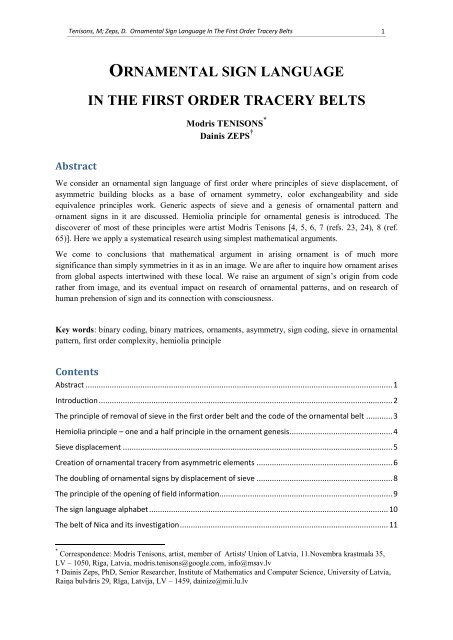
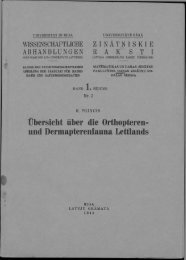
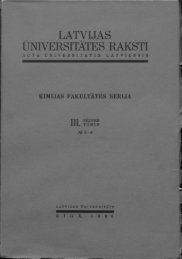
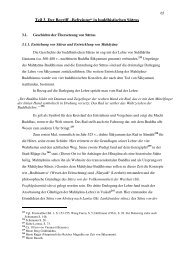
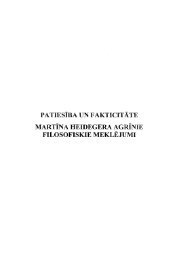
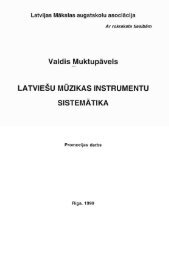
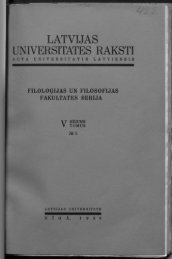
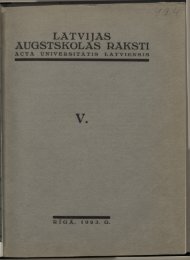


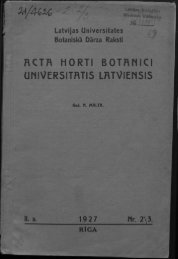
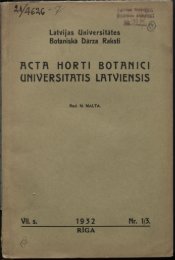
![LATVIJAS] - DSpace](https://img.yumpu.com/11778577/1/190x249/latvijas-dspace.jpg?quality=85)
